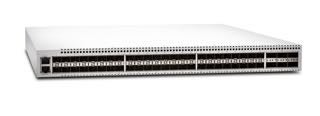The Open Compute Platform launched its networking effort in 2013 in a bid to disrupt the business model of big networking vendors. One of those big vendors is Juniper Networks. Today, in a surprising move, Juniper announced that it is embracing the Open Compute Platform with its own open hardware switch, the OCX 1100. The […]
The Open Compute Platform launched its networking effort in 2013 in a bid to disrupt the business model of big networking vendors. One of those big vendors is Juniper Networks. Today, in a surprising move, Juniper announced that it is embracing the Open Compute Platform with its own open hardware switch, the OCX 1100.
The promise of the Open Compute Project’s networking effort is a “white box” for networking gear: networking equipment built on open hardware specifications that are not tied to specific operating systems. Juniper historically has built its own hardware, with its own silicon, and then used its own Junos operating system on top. Though Open Compute might on the surface appear to be directly competitive with the Juniper business model, Jonathan Davidson, SVP and GM, Security, Switching and Solutions Business Unit at Juniper, disagrees.
“Really we see the Open Compute Project and our OCX product specifically as a new category that is additive to (not competing with) the traditional switching market,” Davidson told Enterprise Networking Planet.
Davidson added that Juniper sees the OCX as rounding out its portfolio, not overlapping with existing products. The goal with the OCX is to open up opportunities with massive-scale cloud builders who are currently using alternative platforms, such as whitebox switches with internally developed or open-source operating systems.
 “Many of these customers—and others who would follow in their footsteps—would prefer a platform that doesn’t require them to internally carry the burden of support, installation and maintenance, but still delivers on the minimalist design principles,” Davidson said. “That’s what we are delivering with the OCX.”
“Many of these customers—and others who would follow in their footsteps—would prefer a platform that doesn’t require them to internally carry the burden of support, installation and maintenance, but still delivers on the minimalist design principles,” Davidson said. “That’s what we are delivering with the OCX.”
While Juniper does have its own proprietary silicon that is used in its routing gear, Davidson noted that Juniper has been using merchant silicon as part of its switching portfolio since 2008. For the new Open Compute Platform-based OCX 1100, Juniper will be using the Broadcom Trident II ASIC.
From a switch configuration perspective, Davidson said that the OCX supports 48 ports of native 10GbE for server connectivity and up to six 40GbE ports for uplink connectivity. Each 40GbE port can also be broken out into four 10GbE ports (for a total of 72 x 10GbE ports per switch), providing additional options for server connectivity.
Linux is a key part of the Open Compute Platform’s networking strategy. As a result, Juniper is making its Junos operating system available to run on Linux. Junos has its roots in the open-source FreeBSD Unix operating system.
“We partnered with Wind River to use their commercial version of Yocto Linux as a base operating system that runs Junos in KVM,” Davidson said.
Davidson added that the Linux Junos approach is similar to how the vendor previously implemented Junos on the QFX5100 Metafabric Qfabric switch, which was announced back in October of 2013.
Juniper’s OCX will also be able to participate in a Software Defined Networking (SDN) deployment that uses Juniper’s Contrail controller.
“Contrail creates overlay networks using standard routing protocols. It can run over essentially any physical underlay, including a network built on OCX,” Davidson said. “In this model, Contrail would create overlay tunnels over the physical network infrastructure consisting of OCX switches and any other switches deployed in the network.”
Sean Michael Kerner is a senior editor at Enterprise Networking Planet and InternetNews.com. Follow him on Twitter @TechJournalist.

Enterprise Networking Planet aims to educate and assist IT administrators in building strong network infrastructures for their enterprise companies. Enterprise Networking Planet contributors write about relevant and useful topics on the cutting edge of enterprise networking based on years of personal experience in the field.
Property of TechnologyAdvice. © 2025 TechnologyAdvice. All Rights Reserved
Advertiser Disclosure: Some of the products that appear on this site are from companies from which TechnologyAdvice receives compensation. This compensation may impact how and where products appear on this site including, for example, the order in which they appear. TechnologyAdvice does not include all companies or all types of products available in the marketplace.